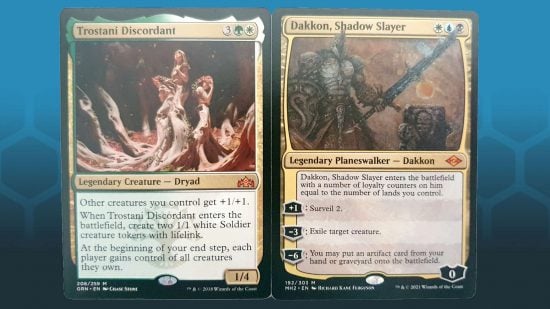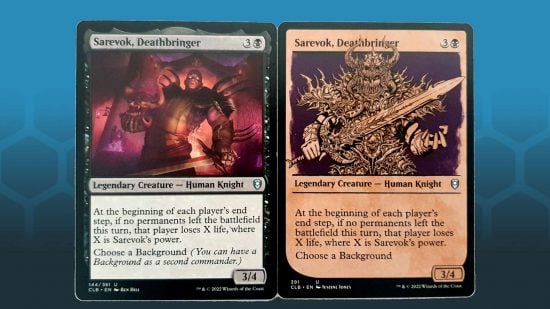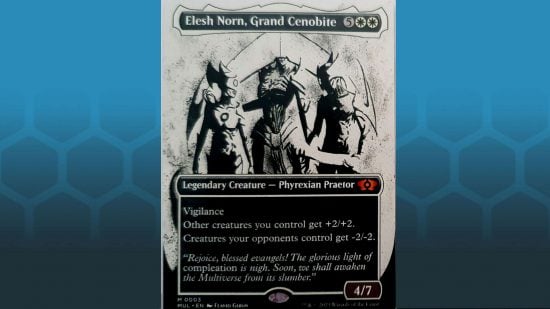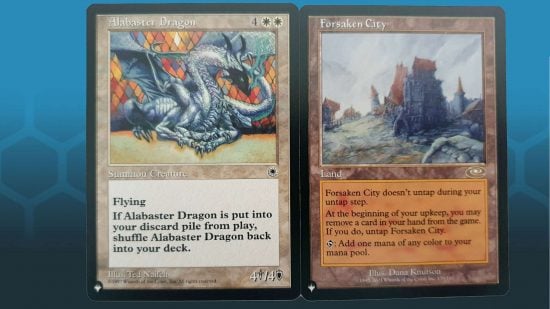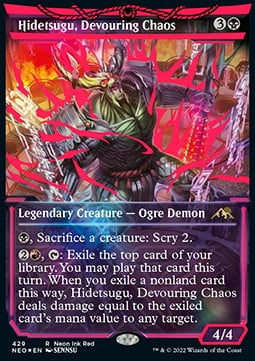The four MTG card rarity levels reflect how frequently each card is printed within a given MTG set. It doesn’t necessarily reflect how powerful those cards are – rarer cards tend to be more complex, but common cards can still be very potent in the right circumstance.
This guide explains the rarity of cards in printed MTG sets: things are a little different when it comes to assembling MTG Arena decks. If you want to know about some staggeringly rare Magic the Gathering cards, check out our guide to the most expensive Magic cards ever printed.
In this guide we’ll examine the basics of MTG card rarity, how to identify rare cards, and then uncover all the ways that things get more complicated from there.
How to identify Magic card rarity
You can identify Magic Card rarity based on the colour of its set icon.
| Rarity | Set icon color |
| Mythic rare | Orange |
| Rare | Gold |
| Uncommon | Silver |
| Common | Black |
The rarity is also printed as a letter following the card’s set number, at the bottom of the card. Old MTG sets may be missing either of both of these features, in which case you’ll need to search on Gatherer to identify the card rarity.
MTG Mythic rares
The number of cards within Magic booster packs, and how many of each rarity types, has changed over the years. Today there are multiple types of booster pack for each MTG set, so we’ll focus on draft boosters. Most draft booster packs contain sixteen “slots”; one rare, three uncommons, ten commons, one basic land, and one slot that may be either a foil card (of any rarity) or a token.
One in every 7.4 draft booster packs contains a mythic rare instead of a regular rare, according to an article by lead designer Mark Rosewater. Although you’re less likely to get a Mythic rare at all in a booster, each mythic rare is only half as common as each rare, because far fewer unique Mythic rares are printed for each set.

If, like us, your desire to open packs and find mythic rares outstrips your budget and any sense, we recommend watching pack opening videos on YouTube as a distraction, and a reminder that it’s very rare to actually open the most valuable cards. We like Tolarian Community College for the Professor’s charming Gen X vibes.
Art treatment rarity
Many Magic cards are printed with multiple different “treatments”; for example, a basic version, an alternate art version, plus foil versions of both of those.
The relative scarcity of these different treatments is not considered part of the card’s rarity. However, some art treatments of cards can be staggeringly rare.
The most extreme example of this is is the One of One Ring. It’s a variant of the mythic rare One Ring card from the Lord of the Rings: Tales of Middle Earth set, with text in elvish, and a serial number marking it as 001 of 001 copies ever printed. MTG fan and musician Post Mallone bought it for $2 million.
Bonus sheet rarity
Several MTG sets have contained a ‘bonus sheet’ of thematically appropriate reprint cards, which can be used in limited games but aren’t considered part of the set for other purposes – they don’t become part of the MTG Standard rotation if they’re printed in a Stadard-legal set. This began with the Mystical Archive in Strixhaven: School of Mages.
If a set has a bonus sheet, each draft booster contains one bonus sheet card. The community consensus is that in every 15 packs, 10 will contain an uncommon bonus sheet card, four will contain a rare, and one will contain a mythic rare.
The List
One in four MTG Set boosters contains a card from ‘The List’. This is a curated and periodically updated list of previously-printed MTG cards. According to Mark Rosewater, “commons, uncommons, rares, and mythic rares” on the list can be found “at the proper rate to one another”.
These cards are printed as if they were a card from an old set, using the same art, card frame, text, and set symbol. A small Planeswalker symbol in the bottom left corner indicates that the card comes from the list.
Card rarity and legality
Certain MTG formats limit which cards can be included in your deck based on their rarity. The most popular is MTG Pauper: an MTG Pauper deck can only contain cards that have been printed at common rarity. The Peasant format is similar, but decks can contain up to five uncommon cards.
MTG card rarity and value
A rare MTG card is not always an expensive MTG card. Two main factors drive the cost of MTG cards: collector appeal, and demand from competitive players.
Hidetsugu, Devouring Chaos was a rare card printed in Kamigawa: Neon Dynasty. The basic version of the card is essentially worthless: it’s just not a very good card in competitive magic. Five different neon ink treatments of the card, with variant art, were printed. The rarest neon red version of the card is worth over $1,000.
Deadly Dispute was a common card printed in Adventures in the Forgotten Realms and Commander Masters: Battle for Baldur’s Gate. It sees play in Commander, Pioneer, and Pauper. At around $2 it doesn’t have a crazy high price, but still costs more than most rare cards printed in each new set.
If all this talk of card prices has made you anxious, check out our guide to MTG Arena Codes, where you can unlock some free booster packs (and hopefully some wildcards). Or do what an increasing number of people do, and build an MTG Commander deck – it’s a lot easier less painful to buy that Mythic rare when you only need one copy.
Source: Wargamer



